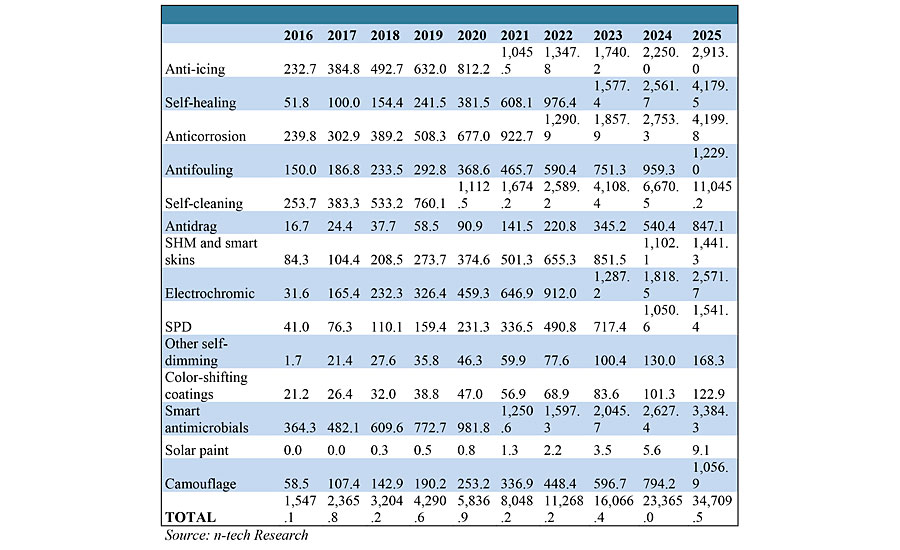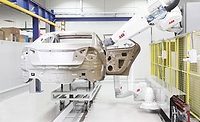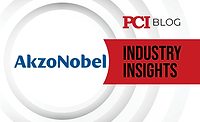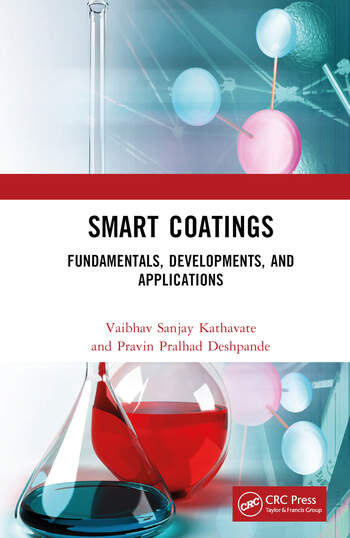Smart Coatings: The Next Big Opportunity in the Coatings Industry

TABLE 1: Ten-year forecast of smart coatings markets by functionality ($ millions).
In their continual search for high value-added opportunities, one of the most attractive prospects over the next decade will be so-called smart coatings -that is coatings that respond “intelligently” to various mechanical, electrical, thermal and optical stimuli.
Smart coatings have been a focus of the coatings R&D environment for several years, but are now quickly achieving functionalities sufficient to take them to the commercial level. At the same time, more smart coating ideas are starting to be investigated -n-tech is hearing that when large coatings firms brief the R&D community on areas that they might fund, smart coatings are mentioned increasingly often.
This is in line with n-tech’s latest research, which indicates that the market for smart coatings is already at $1.5 billion, can be expected to reach $8.0 billion by 2021 and then go on to almost $35 billion by 2025. This would put smart coatings at a share of just under 20 percent of the entire worldwide coatings market in 2025. Table 1 provides a summary of our projections of smart coatings revenues of the next decade.
A Shifting Opportunity Landscape
One word of caution here: much of the dramatic growth that n-tech expects to see in the smart coatings business in the next decade will come at the expense of existing products. Smart anti-icing coatings can reduce the amount of antifreeze used and lower the amount of corrosion that traditional anti-icing treatments cause. So at the right price these advanced de-icing coatings would soon cause a decline in the market for traditional de-icers.
As n-tech sees it, this kind of thing has profound consequences for the coatings industry. It will certainly open up opportunities for start-ups. We already have SLIPS Technologies (omniphobic coatings) and autonomic materials (self-healing coatings) pioneering on this path. We anticipate that it will not be long before venture capitalists will start to take a lot more notice of smart coatings.
For the coatings industry, the message of smart coatings is decidedly more mixed. From what we have heard, a lot of people in the smart coatings community believe that the large coatings and chemicals companies are dragging their feet on bringing smart coatings to market because they fear that these novel coatings will cannibalize existing coatings lines.
In another version of this story the big coatings firms are just unwilling to fund external research and want to do everything in house. We have no idea whether any of this is actually true, but it does make sense. n-tech believes that the arrival of smart coatings is going to be quite disruptive for the large coatings makers.
We think they may find some of their old lines quickly go out of date, so they may face risks and the need to invest in R&D that they didn’t quite expect or plan for. For some established coatings firms, the smart coatings revolution may actually creep up on them and catch them unawares.
The Smart Coatings Market in 2016
The point is that although the smart coatings business will generate $1.5 billion in 2016, a lot of these revenues at present come from very specialty applications.
For example, n-tech has pegged more than $360 million in 2016 from smart antimicrobials, which expect to be used in applications such as preventing the spread of resistant microbe and hospital acquired infections on surgical tools, implants and critical surfaces in hospitals. Then there will be another $620 million or so in 2016 revenues from smart anticorrosion, anti-icing and antifouling coatings, which together n-tech is referring to as smart protective coatings.
These are undoubtedly large sums of money, but the technological developments from which they are derived seem less than revolutionary because the use of this current generation of smart coatings is so narrow. Also, because the price of these coatings is high, the comparatively large revenues mask a relatively low use of smart coatings in real terms at the present time.
Smart Coatings Market Growth by 2021: Billion Dollar-Plus Market Sectors
As n-tech sees things, five years from now, the smart coatings revolution will be much more visible than it is now. We anticipate that some of the larger coatings firms that are ignoring this revolution now will by then have found themselves in much the same position as analog camera firms that ignored digitalization. Here we note – by way of cautionary tale – that Kodak did respond to the strategic threat of digital cameras, just too little and too late.
A secondary – but very interesting – question is how the spate of mergers and acquisitions that we are currently seeing in the coatings/specialty chemicals space will impact the emergence of specialty coatings. Will this M&A activity speed up the adoption of smart coatings as part of the product lines of great coatings companies on the grounds that management thinks new coatings companies needs new product strategies? Or will managers of merged companies be too busy putting out organizational fires to make novel products their priority?
In any case, we think by 2021 smart coatings will be plenty in evidence. The anti-icing coatings that we mentioned above will be generating well over $1 billion, which will make them hard to ignore. But we think that the big change will be that cost declines, performance improvements and technological evolution will have worked their magic to “popularize” smart coatings and open up vast consumer markets to them.
Consider, for example, smart anticorrosion coatings. This is a $240 million market today, with most of these revenues coming from very demanding applications – preventing damage to offshore oil rigs would be a good example. However, n-tech believes that by 2021, the price points for smart anticorrosion coatings will have reached a point where high-end autos and trucks are going to start using these coatings. By 2021 we see smart anticorrosion markets as generating about $920 million in revenue.
We see a similar situation with smart self-cleaning coatings. These are already a real product, but are mostly low-performance and not especially long lasting. One can find such products in the automotive aftermarket or in the niche market for residential self-cleaning windows. But many of the products that are out there right now are little more than novelties.
A close look at the R&D going on in the self-cleaning field, however, has convinced n-tech that we are on the cusp of major improvements in self-cleaning technology, and we believe that there are so many areas where a viable class of self-cleaning coatings could be applied that we are seeing $1.7 billion in revenues from self-cleaning coatings in 2021.
Not All Smart Coatings Will Be Winners
As all of this suggests, n-tech is quite bullish about the prospects of smart coatings. However, not every smart coating can be a winner. In some cases, this is just because the technology is so far from being commercialized that it might take a decade to generate any revenues at all.
Solar paint is the best example here. The idea of solar paint is that you coat a surface, slap on a couple of electrodes and you have an embedded photovoltaic panel capability. There are some interesting experiments in this area too, but absent a genuine breakthrough, we don’t see this idea making much money for the coatings industry for quite some time to come.
And in other areas, new functionalities may be better provided by means other than smart coatings. For example, OLED technology may be a better way to go in many circumstances than a color-shifting coating. Also, while electrochromic and SPD coatings for smart windows are likely to be money-spinners, it is unclear to n-tech that the half a dozen other self-dimming window coatings are going to make much money.
By n-tech Research, Glen Allen, VA
Looking for a reprint of this article?
From high-res PDFs to custom plaques, order your copy today!









